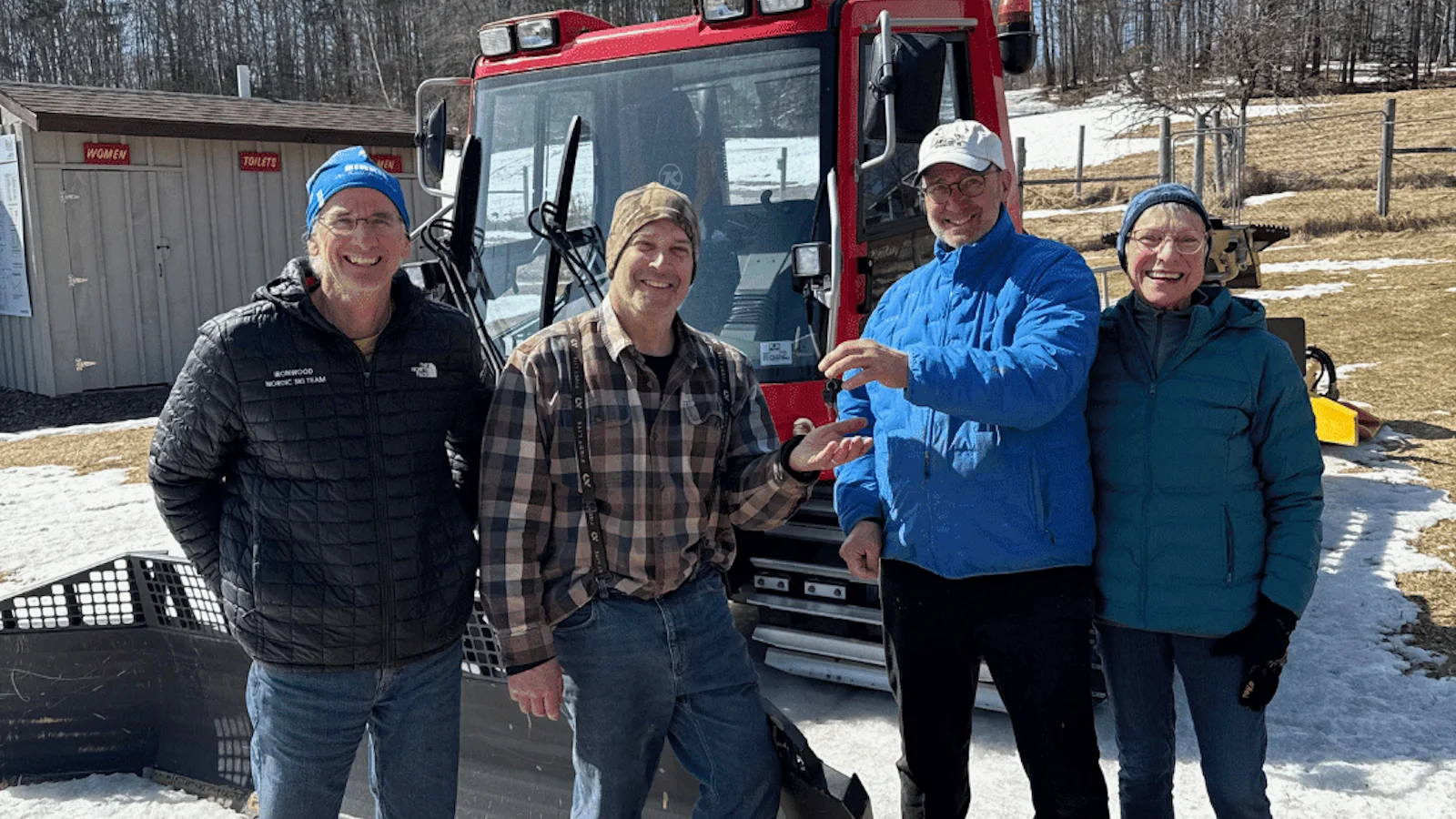With dawn still hours from the horizon, the silhouette of a tall, thin figure slips from a doorway and melts into the encompassing blackness of a January morning in Michigan’s far northern reaches of the Upper Peninsula.
The trio of stars in Orion’s belt wink at the three degrees that register on the thermometer as Eric Anderson, the man behind the shadow, breaks the silence–his boots crunching as he begins his winter commute across the parking lot from his home to the metal barn looming fifty yards away.
Once inside, Anderson takes his place behind the wheel of a pisten bully–a bulldozer’s kin, that’s been built for the snow–and plots his predawn course. By 4 a.m., he already knows which of the 100 miles of trails surrounding him takes priority for transformation.
Thus, nestled in his happy place, he rumbles out of the gargantuan garage and sets about the mechanical dance he has perfected over the last 30 years–finessing hardpack into perfectly tamped icing sugar to be served up to the throngs of happy skiers that visit the cross-country ski haven he’s lovingly crafted: Active Backwoods Retreat (ABR).
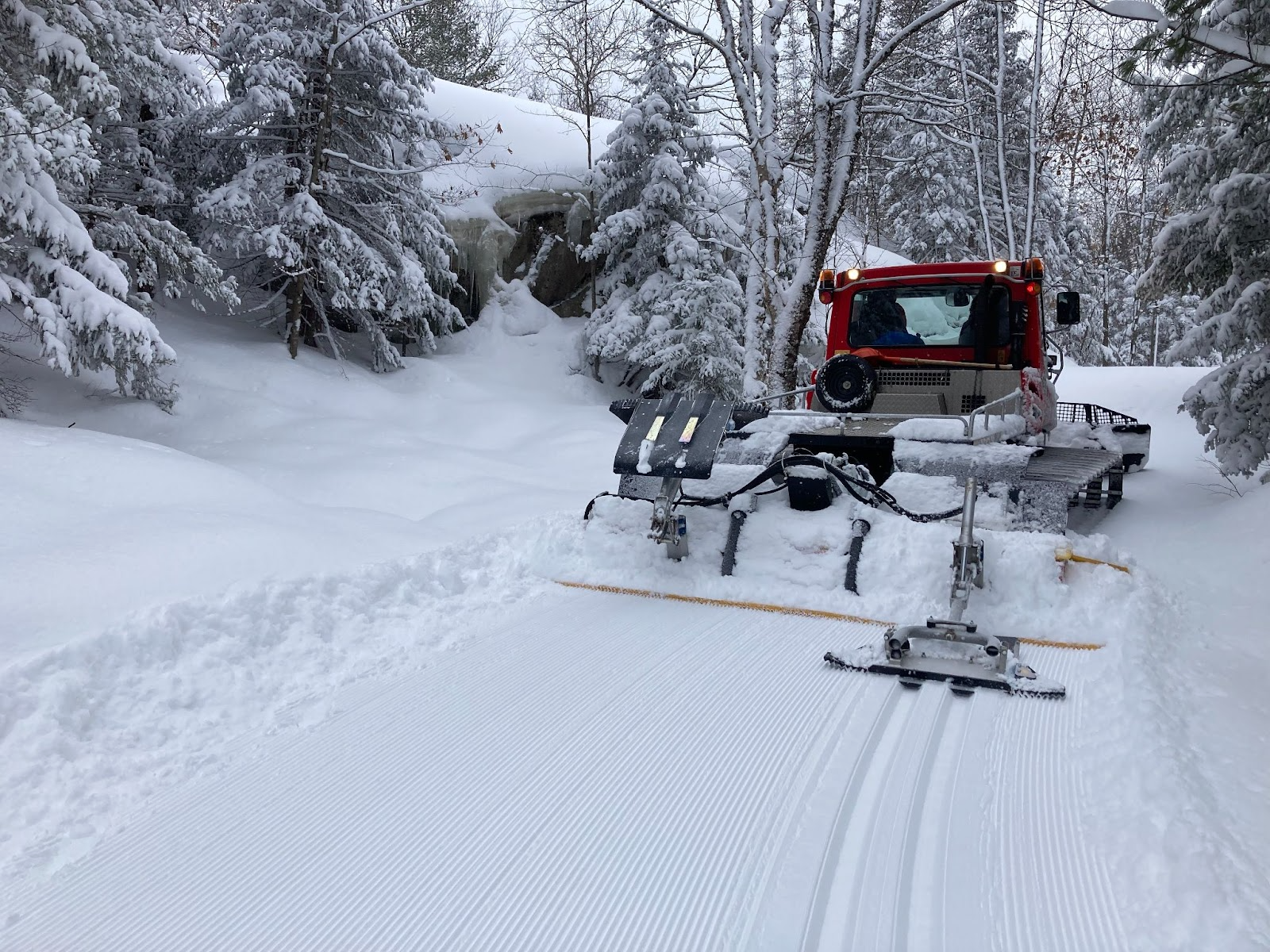
The pisten bully in action, grooming the ABR trails. (Courtesy of Eric Anderson)
ABR lies on more than 1,100 acres along the Montreal River, in Ironwood, Michigan. It has been Anderson’s life’s work–an endeavor that has created a rich resource for the residents of Ironwood, as well as the broader community of cross-country skiers from the Midwest and beyond.
Now, in an act of supreme generosity, Anderson and his wife, Angela Santini, are giving ABR away to a nonprofit foundation to ensure that the resource they’ve built over the last three decades is sustained well into the future.
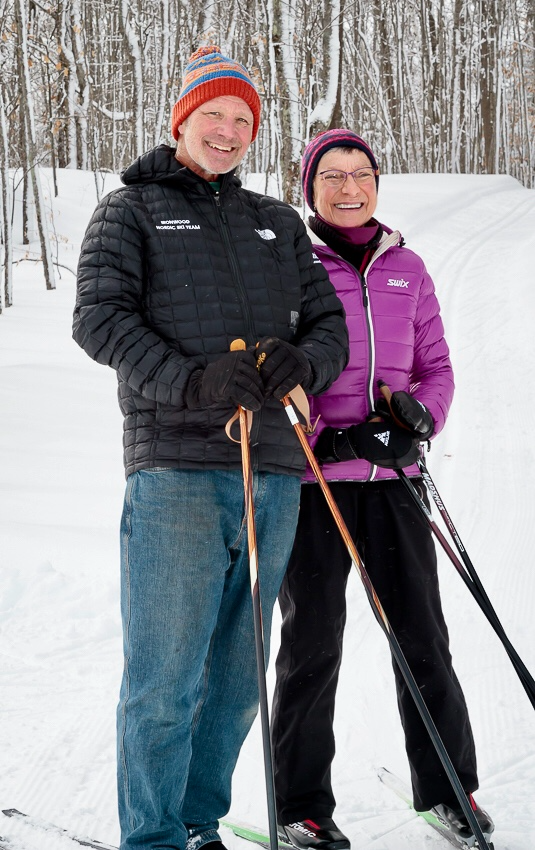
Eric and Angela on the trails. (Courtesy of Eric Anderson)
A Nonprofit Is Born
As of April 2025, ABR has transitioned to the Anderson Bluffs and River (ABR) Trails Foundation, a nonprofit dedicated to preserving both the land resource and founding vision behind ABR, with integrity.
On remaining true to the original vision, ABR Trails Foundation board president, Will Andresen, said, “The board spends a lot of time thinking about this. ABR's greatest marketable strengths are its scenic trails, excellent grooming and friendly people.”
“We are working hard to be sure that we retain those strengths going forward. This is our product, and we envision very little change related to this product.”
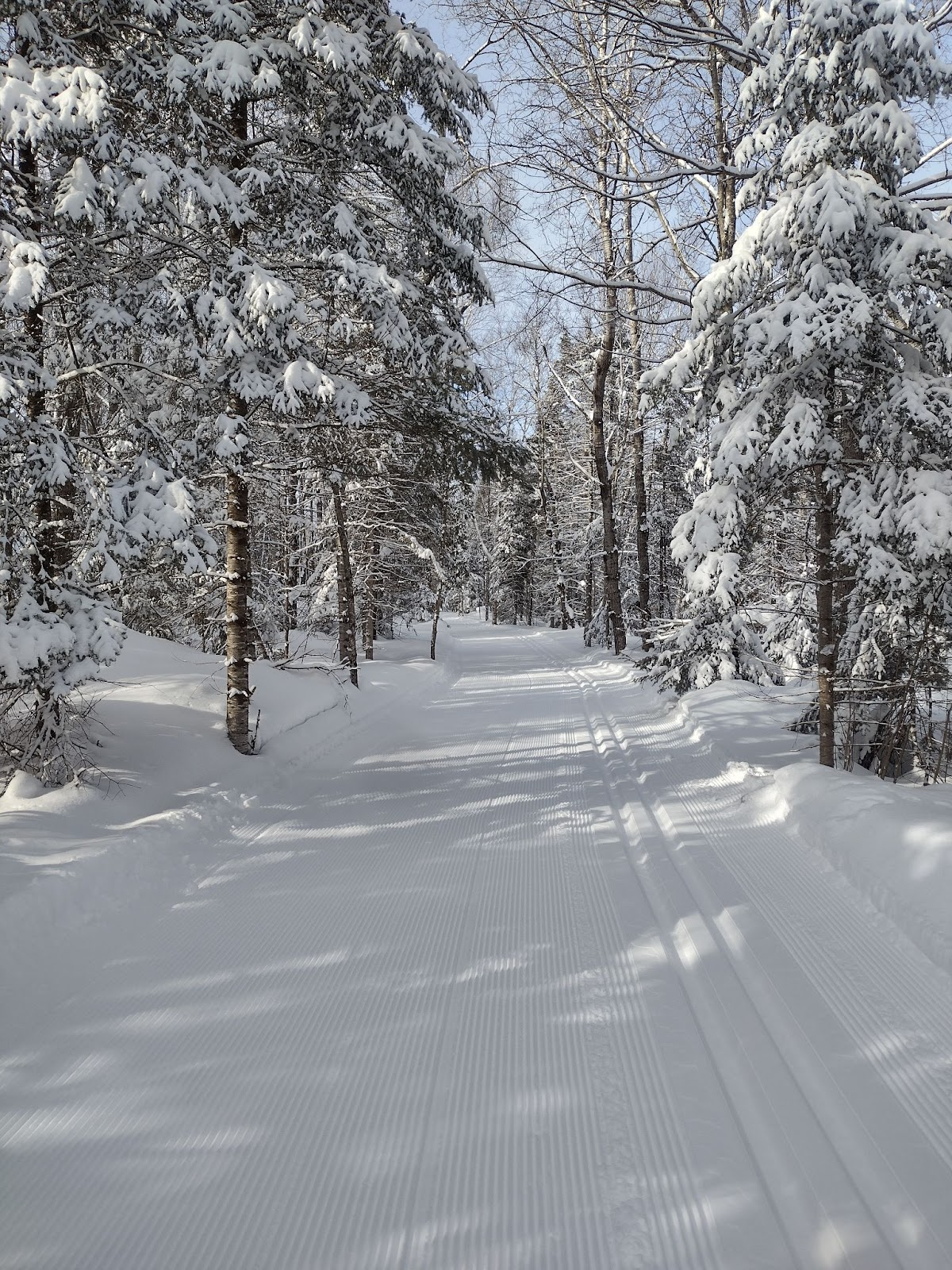
Woodland ski trails on the ABR campus. (Courtesy of Eric Anderson)
Andresen has skied ABR since it first opened in the 1990s–attracted to the beautiful scenery, excellent grooming, and friendly atmosphere–and continues to ski it to this day. He and his wife currently live in a house along the ABR trails, where he can be found skiing every day that the trails are open.
The nonprofit transition has been six years in the making, a testament to the tremendous knowledge transfer required for the endeavor to be successful, as well as to the arduous process that changing business structures can be.
The major transition was spurred by a heart failure that founder, Eric Anderson, suffered in 2019, and the realization that ABR wouldn’t survive without a plan for the future in place.
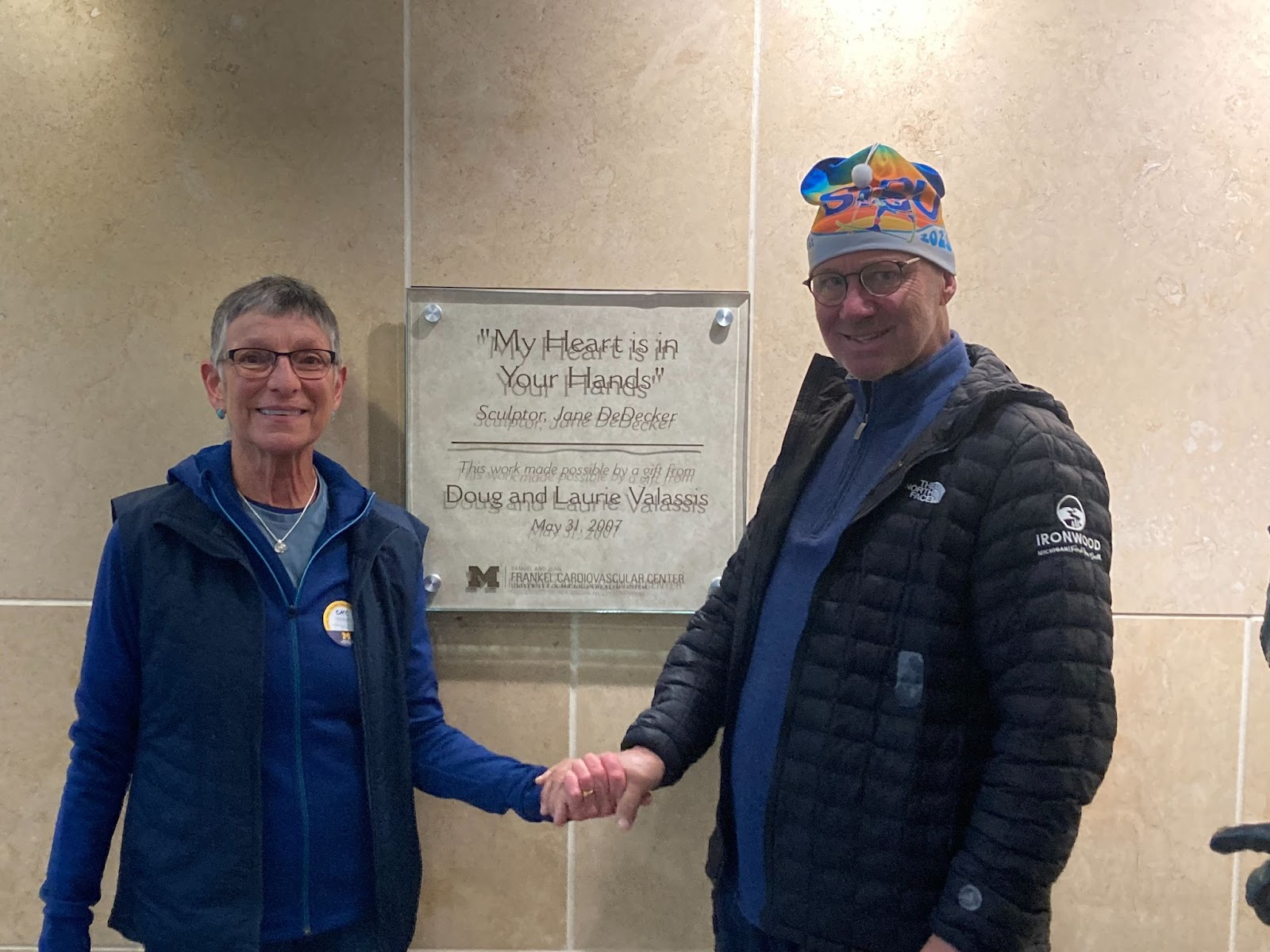
Angela and Eric before his heart surgery. (Curtesy of Eric Anderson)
Faced with the reality of shifting circumstances, Anderson and Santini got serious about laying the groundwork for a plan to preserve and sustain the legacy they’d built once Anderson’s health stabilized.
The couple couldn’t bear the thought of selling to a private buyer who could change the palpably welcoming “ABR vibe,” or potentially develop the land into something different altogether.
Instead, they decided to make the nonprofit transition. In doing so, they chose to donate nearly everything they’d built and bought throughout the creation and growth of the business, to the Foundation. This encompassed the land and associated buildings–including the ski shop, chalet, ski-in cabins, saunas and outbuildings–as well as the groomers, auxiliary equipment and numerous other assets.
Of the monumental decision Anderson said, “My wife and I are very happy to do this,” noting that, “There are a lot of people who don't understand it, but [we] say, there were really no other choices that made sense.”
Deep Roots
While the ABR campus encompasses more than 1,100 acres today, its origins began on the 80 acre tract that Anderson grew up on.
As a boy, Anderson skied rough trails that his family broke through the woods. He and his brother began by taking advantage of the tracks their parents laid ahead of them before the family eventually adopted more sophisticated grooming methods, though nothing compared to today’s operation.
Because of this familial connection to the land and the sport, it was only natural that Anderson initially began the ABR endeavor with his father.
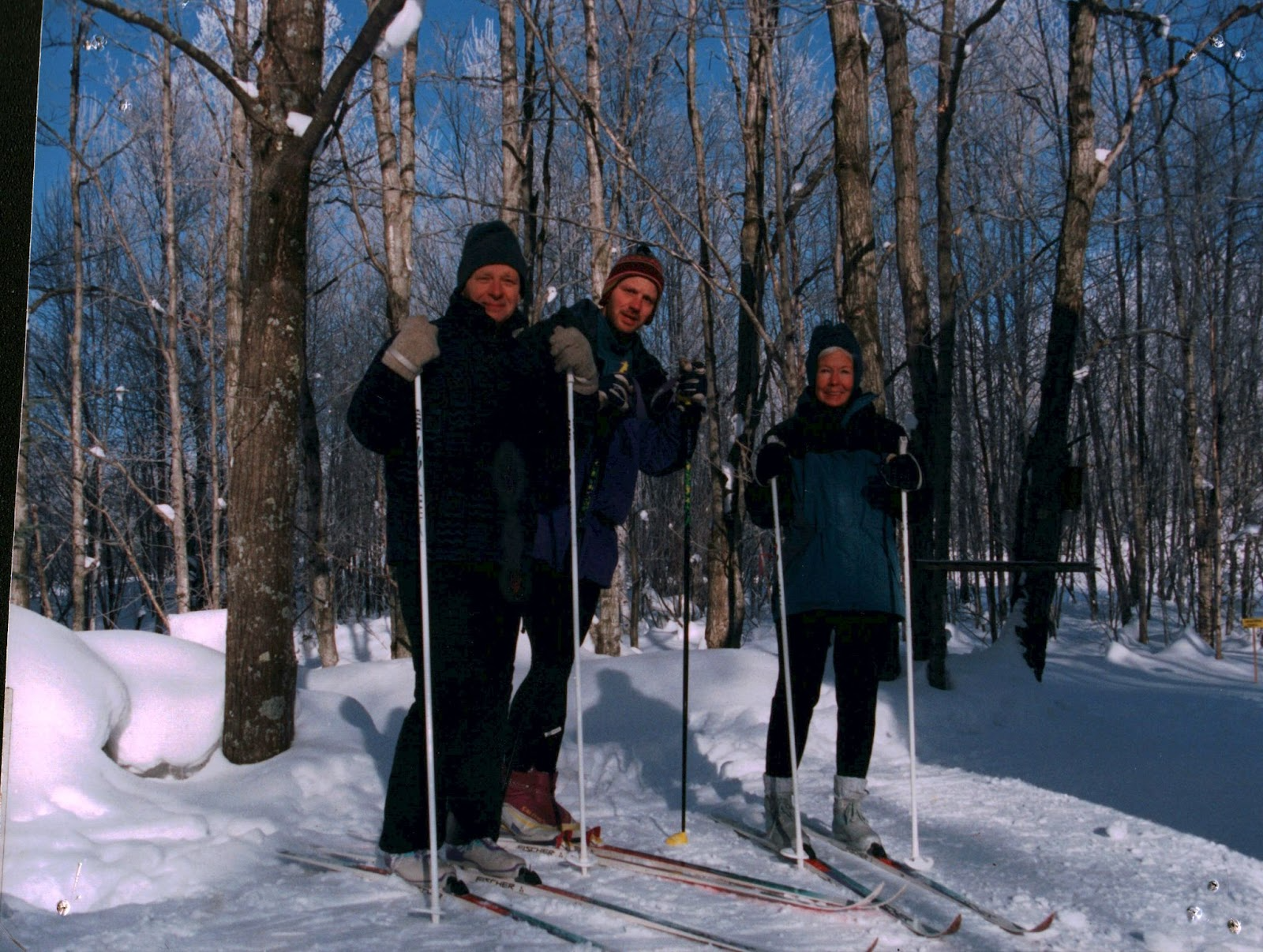
Eric Anderson, center, skiing with his parents. (Courtesy of Eric Anderson)
Following his graduation from high school, Anderson pursued an engineering degree. His work in the field eventually took him to Europe, where he worked for the final four years of his corporate career.
It was while in Europe, inspired by the vibrant silent sports culture around him, that his own dreams of creating Active Backwoods Retreat were kindled.
He knew that he wanted to move back to Ironwood. He also knew that he wanted to find a more satisfying career path. Thus, Anderson began brainstorming, volleying ideas across the Atlantic with his dad, and eventually buying up tracts of land that were adjacent to his family’s plot.
Upon returning home, he and his dad began wrangling their ideas into a business plan. Initially, the pair had been envisioning offering a broader spectrum of outdoor adventures.
In the early years, in addition to cross country skiing they offered kayaking trips, and toyed with mountain biking and destination adventures as well.
However, given the area’s reliable snow, the site’s idyllic scenery, and the family’s friendly disposition, skiing soon outpaced their other offerings and eclipsed their other ideas, and ABR began to emerge as a premier cross country ski destination–one that’s been voted among the best in the nation in recent years.
Anderson acknowledged, “My dad and I had no idea that it was going to grow to the point that it did. I'm not sure why it did. I mean good snow, good grooming, and be kind to the skiers. That's no rocket science.”
“The most rewarding part of the whole business is…everyone's happy, they're thankful and you know, that's a pretty big reward.”
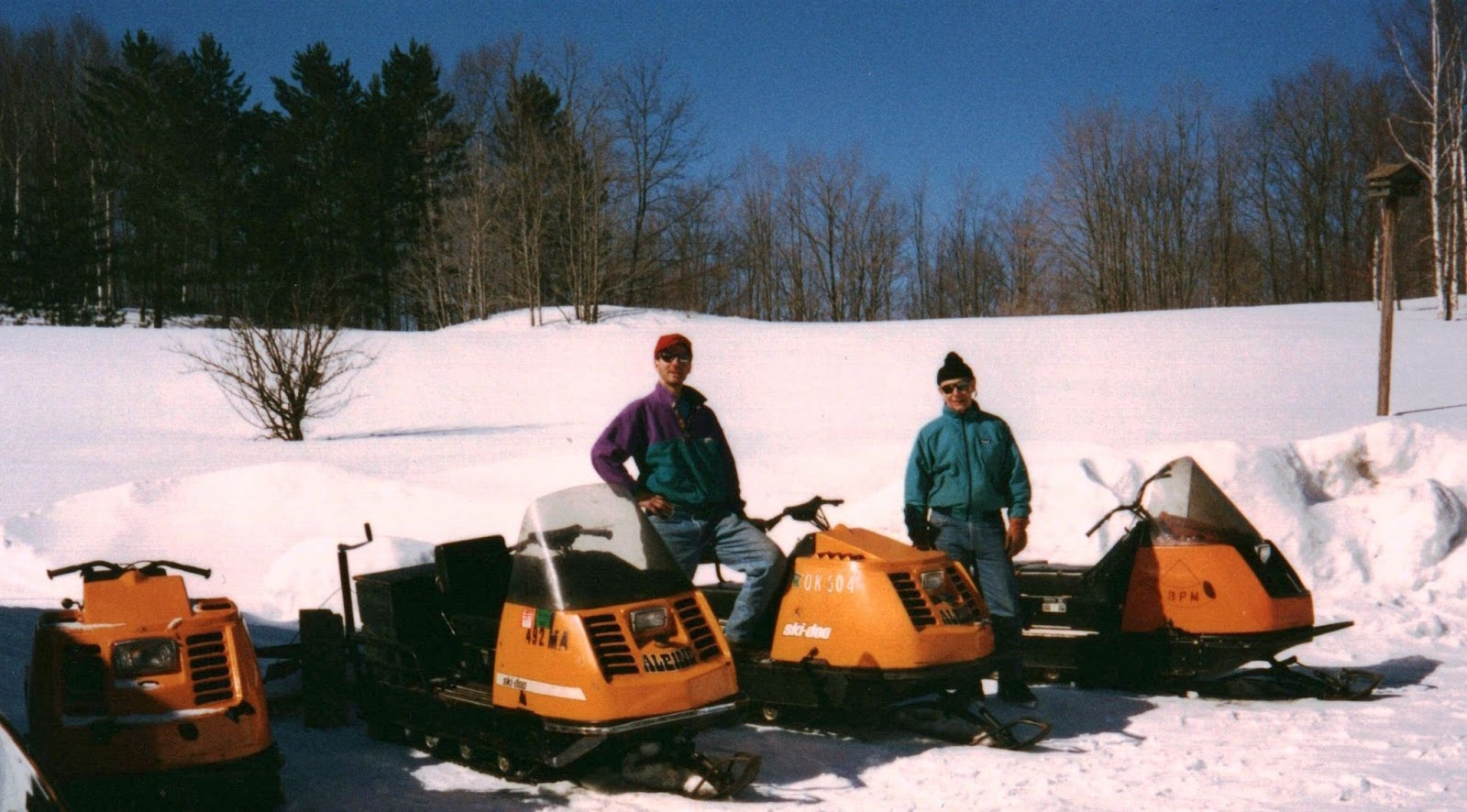
Eric and his dad, Dave. (Courtesy of Eric Anderson)
With the positive response from patrons came additional infrastructure. The duo soon added a chalet, primitive ski-in cabins, and a sauna. Incrementally, the trail mileage also grew–from roughly four miles, prior to opening ABR to the public, to 100 miles today.
Of the impressive trail system, Anderson says, “The goal was to hit a hundred, which we did last year, and I really think 100 is enough. I think 90 is enough. Probably 70 is enough. If you get too big, it seems like you can't maintain them at the quality level that you want to.”
Trail quality is of utmost importance to Anderson. As time has gone by he has turned increasing attention to perfecting the trail grooming at ABR. It was something that he was able to turn his engineer’s focus upon, and it’s something ABR is well known for today, with people traveling from all over the country to learn the art and science of grooming from him.
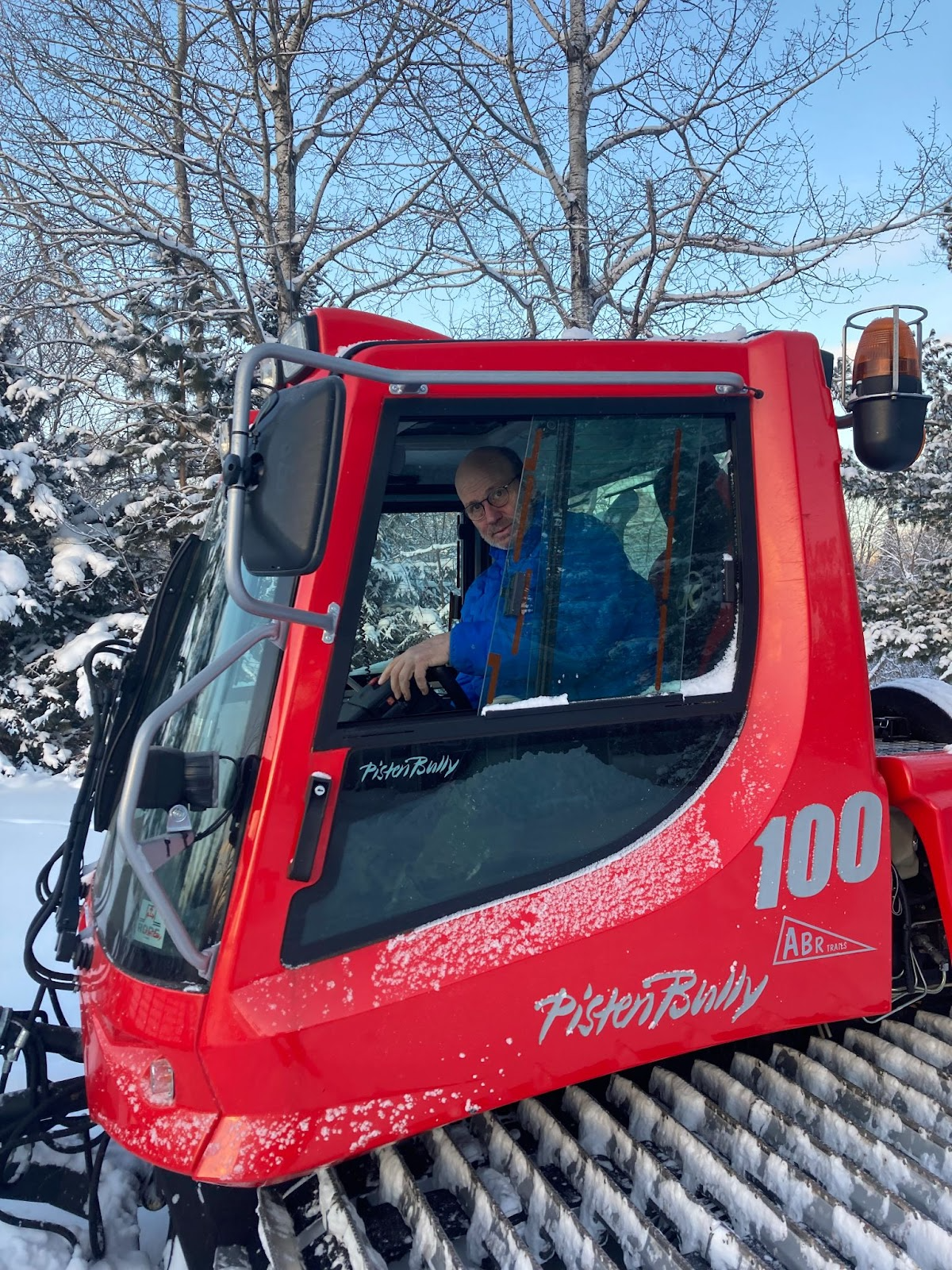
Eric Anderson behind the wheel of a pisten bully. (Courtesy of Eric Anderson)
Though Anderson founded ABR with his father, he has grown and sustained it with his wife, Angela, who has been there since the beginning.
The two had crossed paths in their younger years, both growing up in Ironwood; however, it wasn’t until Anderson was home on a visit from Europe that they made a real connection.
Bleary eyed, he’d wandered down to the breakfast table one morning and found her sitting there drinking coffee. She was a part of a running group that his parents hosted. Upon reuniting, the pair quickly found that they hit it off and they began dating; the rest is history.
Throughout the evolution of ABR, Angela has worked side by side with Anderson, Emerging over the years she as the primary face to greet patrons in the chalet and assist them in the ski shop–a role that while rewarding, she is looking forward to stepping back from so she can spend more time in the woods skiing and snowshoeing.
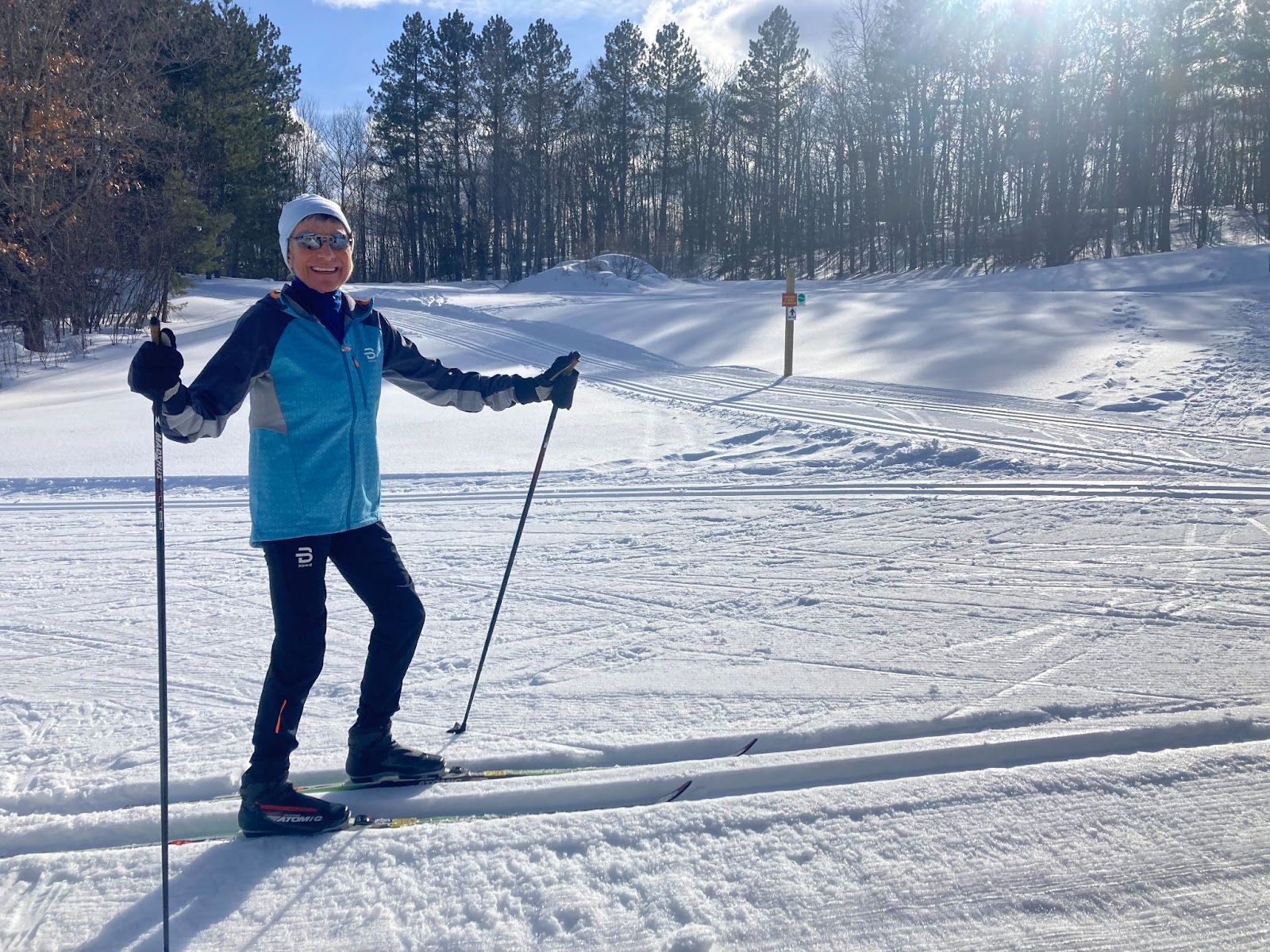
Angela on the trails. (Courtesy of Eric Anderson)
Passing the Baton
Now, after thirty years of bringing dreams to life, Eric Anderson and Angela Santini are giving the gift of a lifetime to the cross-country ski community that has orbited around them. A community that has grown exponentially over the years, and can continue to, because of their generosity.
While big changes are afoot, the core of ABR and how it is run will remain the same. Anderson, for the time being, is staying on as chief groomer and to help maintain equipment. He also intends to volunteer in the ticket booth and ski shop from time to time, but is looking forward to the time he will be afforded to hang out with friends in the chalet.
Through the years spent pouring over the details of the transition, he’s developed complete confidence in the foundation’s ability to take over, saying that, “The board, in my opinion, is very talented.”
While most aspects of ABR are remaining the same, some changes can be expected. The ski-in cabins can now be booked through the online platform Hipcamp, which is akin to Airbnb for camping and rustic accommodations. Additionally, some record keeping practices and methods for retail transactions will be modernized.
“Just a few small tweaks,” Anderson said. Highlighting that, “It's been a real goal of the board not to change what people feel like when they come to ABR. We always want good grooming and a friendly person greeting each person, helping them however they need to be helped.”
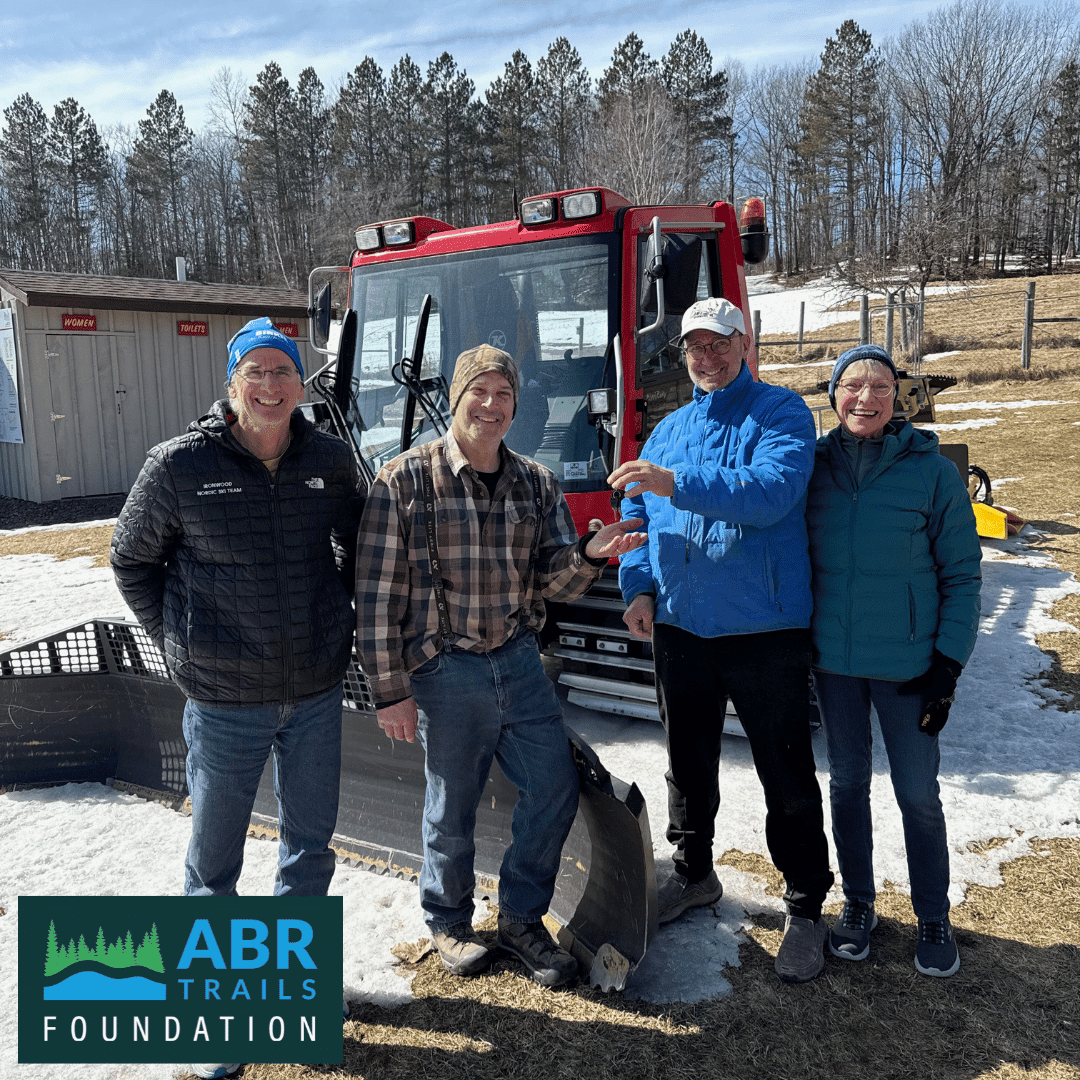
Eric Anderson handing over the keys to the pisten bully. (Courtesy of the ABR Trails Foundation)
In forecasting for the future, the board is also looking into what preparations can be made for low snow years.
“One of our major assets is our usually reliable abundant snow. There's not a lot we can do about that,” board president Will Andresen said.
“However, one of our main goals going forward is to prepare more of our trail system for low-snow periods. We would like to ensure that skiing on natural snow is always a part of the Midwest skiing experience. We are looking at several options for what we are calling ‘golf-course’ skiing, where we will only need a few inches of snow for a fantastic ski.”
While abundant snow has been a pillar of ABR’s draw, Anderson noted that decreased snow fall has been a phenomenon he’s witnessed throughout his lifetime.
“When I was a kid, the two and three foot snowfalls were so common. The last two years have been the most drastic. We've had a dry year, not totally dry, but a couple 100 inch snow years over the last 30, but these last two years have been pretty unusual, especially last year,” he said.
It is this type of forward thinking that is a testament to the Foundation’s commitment to the continued success of ABR, and an example of what Anderson is grateful to hand off to the dedicated team who is carrying ABR into the future.
An attitude echoed by board president, Andresen, when he said, “What excites me most about the future of ABR and the ABR Trails Foundation is that sustaining the ABR legacy will truly be a shared effort by the ski community.”
“We will all own the ABR future, from skiers to volunteers, from donors to community partners, in this generation and the next.”
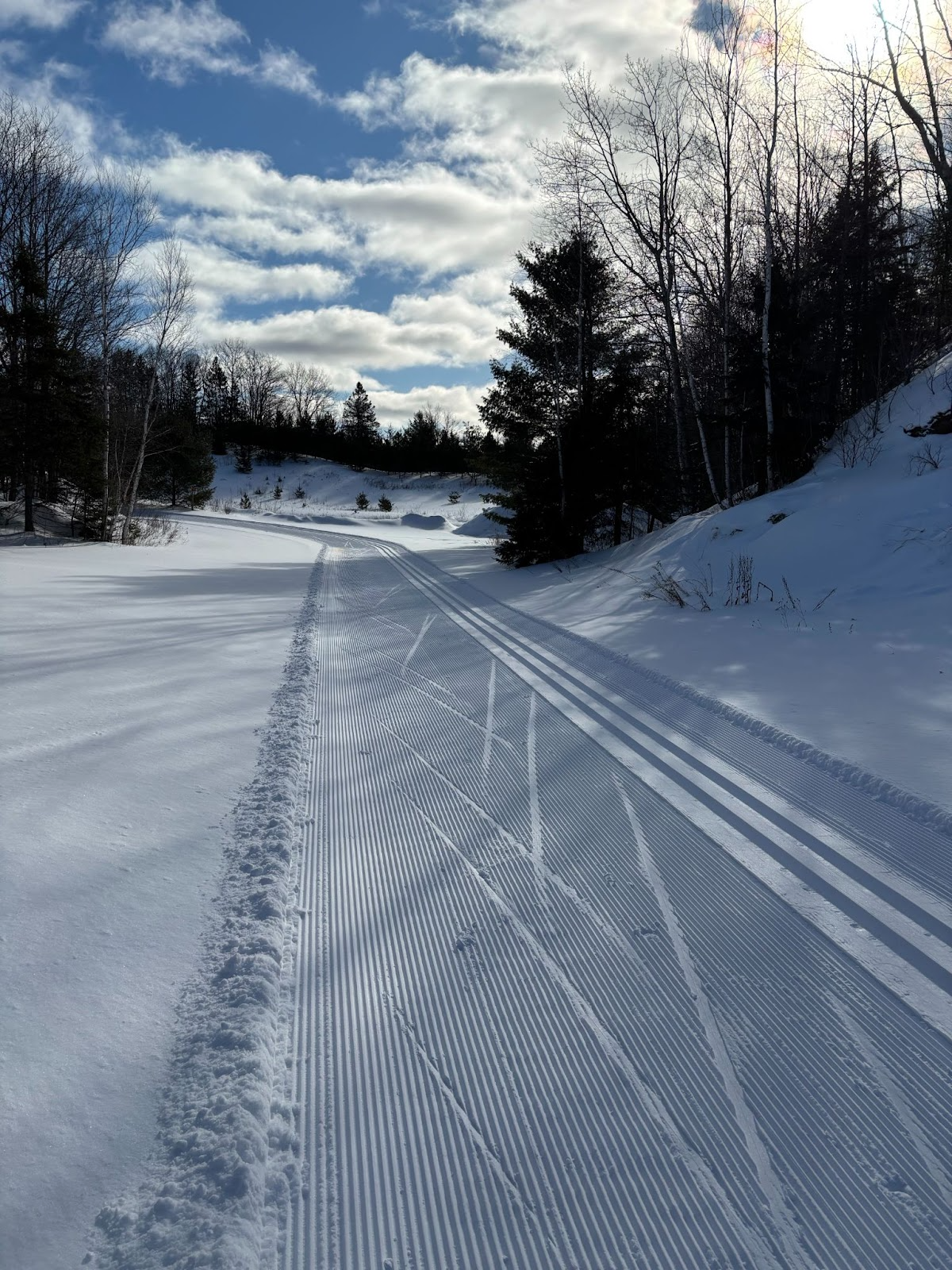
An ABR ski trail that will serve generations into the future. (Courtesy of Eric Anderson)
